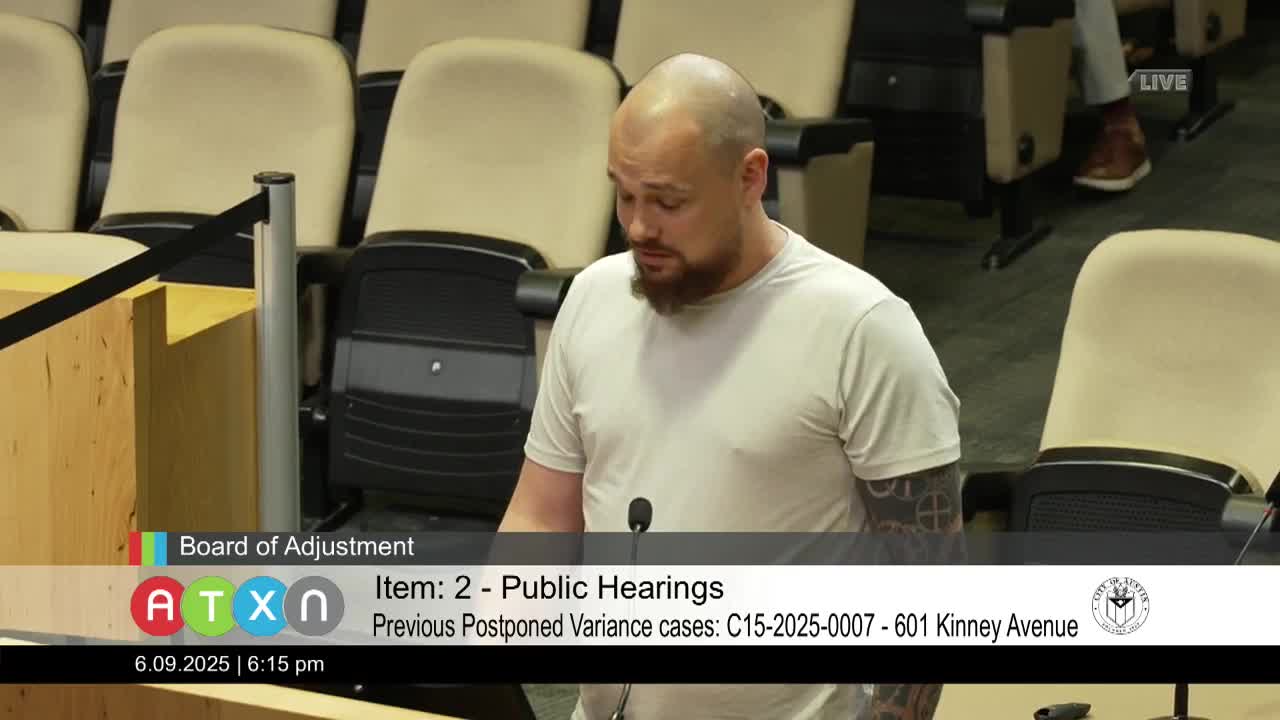Zilker Neighborhood Association opposes 601 Kinney construction due to community safety concerns
June 09, 2025 | Austin, Travis County, Texas
This article was created by AI summarizing key points discussed. AI makes mistakes, so for full details and context, please refer to the video of the full meeting. Please report any errors so we can fix them. Report an error »

In a recent meeting of the Austin Board of Adjustment, community members voiced strong opposition to a proposed construction project at 601 Kinney. The project, which seeks to add 2,455 square feet and a swimming pool to an already substantial home, has raised significant concerns regarding its impact on the surrounding neighborhood and the environment.
Residents highlighted that the proposed addition would not only increase the height of the structure but also its visibility from numerous homes in the area. One speaker emphasized that the building would stand approximately 45 feet above the ground floor, making it visible from at least half of the homes in the community. This raised alarms about the potential for diminished privacy and property values for neighboring homeowners.
Lorraine Atherton, representing the Zilker Neighborhood Association Zoning Committee, argued that the application does not meet the necessary criteria for reasonable use hardship. She pointed out that the construction on a steep slope could jeopardize the stability of homes in the canyon below, citing concerns about erosion and flooding. Atherton noted that the owners could pursue alternative designs that comply with existing codes without the need for a variance, suggesting that the hardships claimed by the owners are self-imposed.
Ted Twyfirth, president of the homeowners association, echoed these sentiments, stating that the proposed changes would negatively affect not just the immediate neighbors but the entire community. He expressed frustration over the lack of acceptable solutions presented by the homeowners and emphasized the potential for unforeseen consequences that could arise from the construction.
Tom Stevenson, a neighbor and former firefighter, raised safety concerns related to the increased impervious cover that the addition would create. He warned that this could exacerbate flooding issues already experienced in the area and complicate emergency response efforts, particularly in the event of a fire.
The discussions at the meeting underscored the community's apprehension about the proposed project and its broader implications for neighborhood dynamics and environmental safety. As the Board of Adjustment considers the application, the voices of concerned residents highlight the importance of balancing individual property rights with the collective interests of the community. The outcome of this case could set a precedent for future developments in the area, making it a critical point of focus for local stakeholders.
Residents highlighted that the proposed addition would not only increase the height of the structure but also its visibility from numerous homes in the area. One speaker emphasized that the building would stand approximately 45 feet above the ground floor, making it visible from at least half of the homes in the community. This raised alarms about the potential for diminished privacy and property values for neighboring homeowners.
Lorraine Atherton, representing the Zilker Neighborhood Association Zoning Committee, argued that the application does not meet the necessary criteria for reasonable use hardship. She pointed out that the construction on a steep slope could jeopardize the stability of homes in the canyon below, citing concerns about erosion and flooding. Atherton noted that the owners could pursue alternative designs that comply with existing codes without the need for a variance, suggesting that the hardships claimed by the owners are self-imposed.
Ted Twyfirth, president of the homeowners association, echoed these sentiments, stating that the proposed changes would negatively affect not just the immediate neighbors but the entire community. He expressed frustration over the lack of acceptable solutions presented by the homeowners and emphasized the potential for unforeseen consequences that could arise from the construction.
Tom Stevenson, a neighbor and former firefighter, raised safety concerns related to the increased impervious cover that the addition would create. He warned that this could exacerbate flooding issues already experienced in the area and complicate emergency response efforts, particularly in the event of a fire.
The discussions at the meeting underscored the community's apprehension about the proposed project and its broader implications for neighborhood dynamics and environmental safety. As the Board of Adjustment considers the application, the voices of concerned residents highlight the importance of balancing individual property rights with the collective interests of the community. The outcome of this case could set a precedent for future developments in the area, making it a critical point of focus for local stakeholders.
View full meeting
This article is based on a recent meeting—watch the full video and explore the complete transcript for deeper insights into the discussion.
View full meeting
